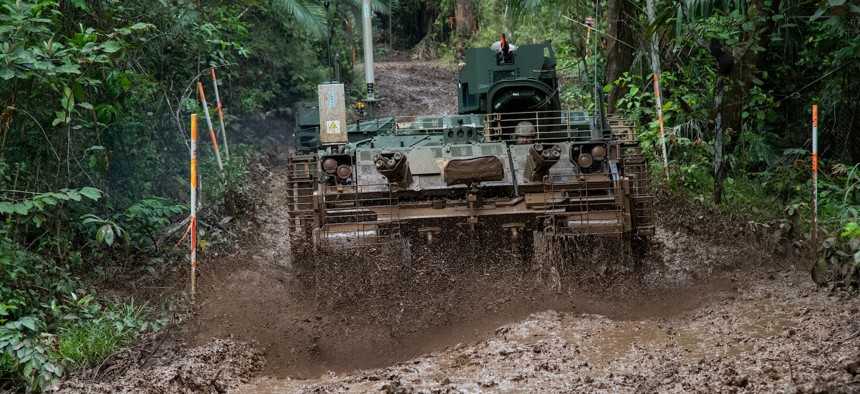
The Army got a long list of marching orders from Defense Secretary Pete Hegseth on Thursday, with deadlines for fielding new weapons and technology, directives to unload old equipment, and orders to merge the service’s futures and doctrine organizations.
Hegseth’s staff didn’t consult the Army while drawing up the memo, a Defense official told Defense One, but it includes a lot of items the service was already working on, or had considered but hadn’t been told to prioritize.
“It is nothing but good news, nothing but excitement for us to build judicious plans and move as fast as we can,” the official said.
Weapons deadlines top the list. Long-range missiles that can hit moving land and sea targets, an apparent reference to the Precision Strike Missile now under testing, are to be fielded by 2027. Every division is to receive unnamed unmanned systems and “Ground/Air launched effects” by 2026. Counter-drone systems are to be sent to maneuver platoons by 2026 and maneuver companies by 2027.
Then there’s offloading outdated equipment and axing wasteful programs. The memo calls out the Humvee, which the service will begin to replace in brigade combat teams this year with its new infantry squad vehicle.
“We don’t want to take them to the next war,” the Defense official said of the Army’s roughly 100,000 older ground vehicles.
The memo gives the service an all-but-explicit order to cancel the M10 Booker light tank program, which the Army has openly said it doesn’t want.
There’s also the Armored Multipurpose Vehicle, the official said, which the Army started buying in 2019 to replace the M113 armored personnel carrier.
“We don’t want that. That’s a box with tracks,” the official said: its mission can be done with an autonomous vehicle, which is what the Army would much rather have.
Other deadlines include:
- 2026: “advanced manufacturing, including 3D printing and additive manufacturing, to operational units.”
- 2027: “AI-driven command and control at Theater, Corps, and Division headquarters.”
- 2028: “Modernize the organic industrial base to generate the ammunition stockpiles necessary to sustain national defense during wartime by implementing 21st-century production capabilities, with full operational capability.”
Reorganization
The memo also orders a dozen moves to restructure, and in some cases shrink, the Army’s organizational structure.
Some armor and aviation units will shrink—particularly ones that fly the AH-64D Apache helicopter, the official said, which is much more expensive to maintain than the newer AH-64E and doesn’t get as much flying time due to low readiness rates.
“We’re not going to buy any more,” the official said. “We’re going to eventually get rid of those and try to turn some of those formations into things that we do need.”
U.S. Army North and South are to be merged into one command focused on homeland defense. Army Sustainment Command and Joint Munitions Command are to be moved under Army Material Command. And Army Futures Command will cease to exist as a four-star outfit and be rolled back into Army Training and Doctrine Command, where its essential functions lived before the service gave it its own headquarters and staff in Austin, Texas.
“This is probably a move in the right direction, but much more detail is needed to fully assess,” R.D. Hooker, Jr., a retired colonal-turned-senior associate at the Harvard Kennedy School’s Belfer Center, told Defense One.
This suggestion had been in the Army conversation in the past couple of years, after it became clear that the Futures Command had not lived up to its mandate of accelerating Army modernization and procurement.
“You can push those people back out to the field, generate combat power at the echelons that we need, instead of potentially having staff that is too big, or multiple headquarters, paying for multiple general officers’ homes,” the Defense official said.
It was also circulated as a potential four-star billet to chop in a larger conversation about the service’s glut of senior leadership.
“Overhauling the entire acquisition process is the more fundamental need,” Hooker added.
That’s also part of Hegseth’s mandate. The memo calls for the Army to rework its budget based on capabilities rather than specific programs, allowing for the service to ditch efforts that aren’t working and reallocate money to something else without needing a new budget.
The Army is also going to experiment with performance-based contracting, so that if a firm isn’t sticking to timelines and delivering exactly what it promised, it doesn’t get paid.
All of this is basically music to the Army’s ears, the Defense official said.
“When a boss says do your job and do it to the best of your ability, as fast as you can and be as efficient as possible – I’m like, hell yeah,” the official said.
The post Hegseth issues Army a lengthy to-do list appeared first on Defense One.




